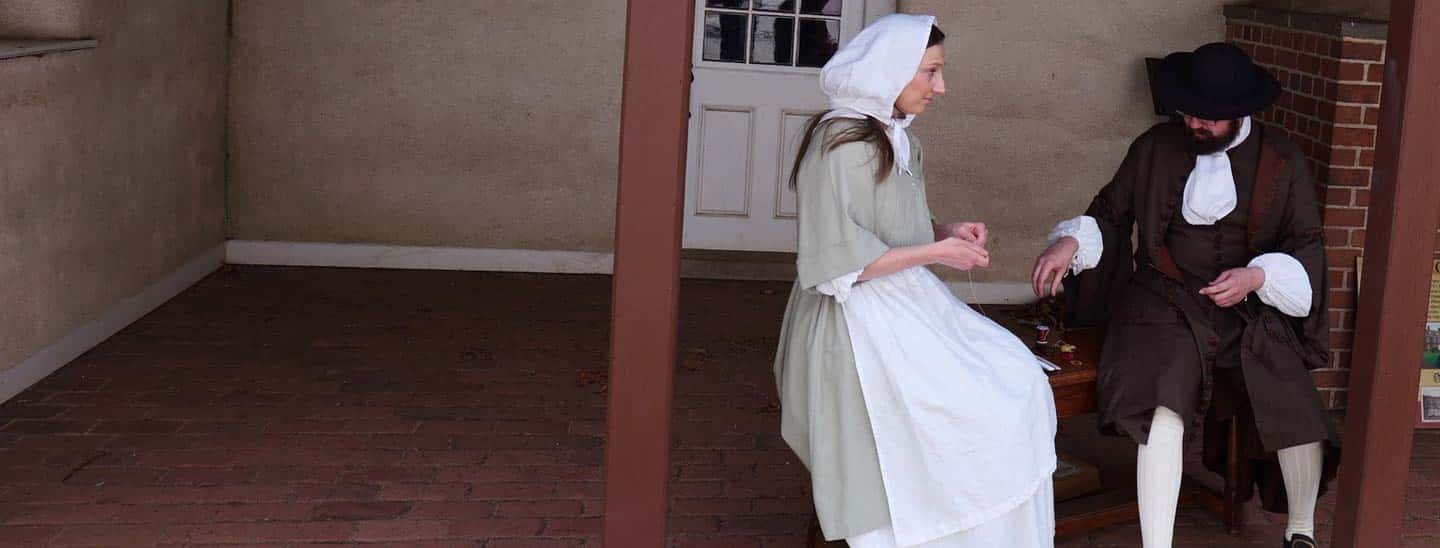
For reservations to experience “nkwiluntàmën: I long for it; I am lonesome for it (such as the sound of a drum)” by Indigenous artist Nathan Young, please go to https://nkwiluntamen.com/
Colonial americans at Pennsbury
-
-
Life in Colonial times
Daily life in colonial times was dictated by the seasons of the year, far more than our lives are today. Summer was a time for growing and preserving food. Long days served Pennsbury residents well as they tended gardens and crops, picked fruits and vegetables, and dried, salted, or pickled produce, herbs, or meat for use in the winter. During the summer the Penns might be in residence, with extra workers cooking elaborate meals for the Penn family and their friends, doing laundry, and possibly even serving on the rowing crew of Penn’s personal barge.
Autumn was by no means quiet. All crops had to be harvested and stored properly before the harsh winter set in. Winter crops were planted, and beer was brewed. Sheep and cows were bred during the fall, and then turned loose to forage through the winter on their own. Chickens no longer laid eggs, and cows stopped giving milk.
Winter was the quietest season of the year. The “little ice age” during this period resulted in extremely cold winters. Large animals such as cattle were butchered during the winter. Beeswax candles were expensive, and candles made from tallow smelled. Rush lights made of reeds dipped in tallow offered low light. So during the long winter nights, residents used only 1-2 candles in a room, making reading or detailed work difficult.
Spring brought a sharp contrast to winter. Fresh food in the form of early crops in the garden (such as spinach) brought welcome relief from the dried, salted, and pickled foods of the winter months. The animals that were bred in autumn gave birth in spring, with cows giving milk after their calves were born. The milk was preserved by churning it into butter, or processing it into cheese. Sheep were sheared, crops planted, and the yearly cycle began anew.
-
-
-
Servants and Workers
In addition to the Penn family, there were servants residing and/or working at Pennsbury. These workers were either paid a salary or, if employed temporarily, given a fee for work performed. James Harrison, for example, spent 5 years at Pennsbury in the 1680s working as the estate’s steward. Elizabeth Seale, a washwoman originally from Germany, was paid to come to the estate and oversee the laundry.
-
-
-
Indentured servitude
Some of the servants at Pennsbury were indentured. Lacking the resources to come to Pennsylvania on their own, these men and women worked for a pre-determined period of years in exchange for transport to America and “freedom dues” once their indenture was complete. It was a gamble! The person who owned your indenture could sell it (and you) to another. Life was uncertain, and you might find yourself like James Reed who died shortly after his indenture was complete. Finally, there was no guarantee that you would be successful on your own once you were free. But many of Pennsylvania’s early leading citizens began their American lives as indentured servants.
-
-
-
Slavery
William Penn had slaves. This surprises many people as it seems out of place in Pennsylvania and inconsistent with his Quaker beliefs.
The first enslaved people came to Pennsylvania in the 1640s. By the time Penn arrived in 1682, slavery was well established in the area. Small farms and business created a model of slavery where families owned only 1-2 slaves who generally lived in the household.
William Penn was keenly aware of the dispute between Quakers. Some Quakers questioned the morality of slavery, while other Quakers, like Penn, held slaves. The Germantown Protest, the first organized protest against slavery took place in 1688, but it would be over 50 years until Quakers agreed that slavery is wrong.
For Sam, Sue, Yaff, Jack, and Peter – and the others whose names we don’t know – slavery at Pennsbury was all too real. We know little about these people as they are not mentioned often in the historical record. But this much we know for certain: there was an early African-American community at Pennsbury and in Pennsylvania that influenced the development of the colony.
-
-
Lenape
William Penn was certainly not the first European to settle in Pennsylvania and make contact with Native Americans already living in the area. In the 1640s, settlers from Sweden and Finland made their homes in what would become Pennsylvania. The Lenape accepted these first settlers in stride, trading freely. Penn’s arrival pushed the trading to new levels as land as well as goods were traded. This equitable solution created an environment where Lenape and settlers were able to live peacefully together for nearly 50 years.
